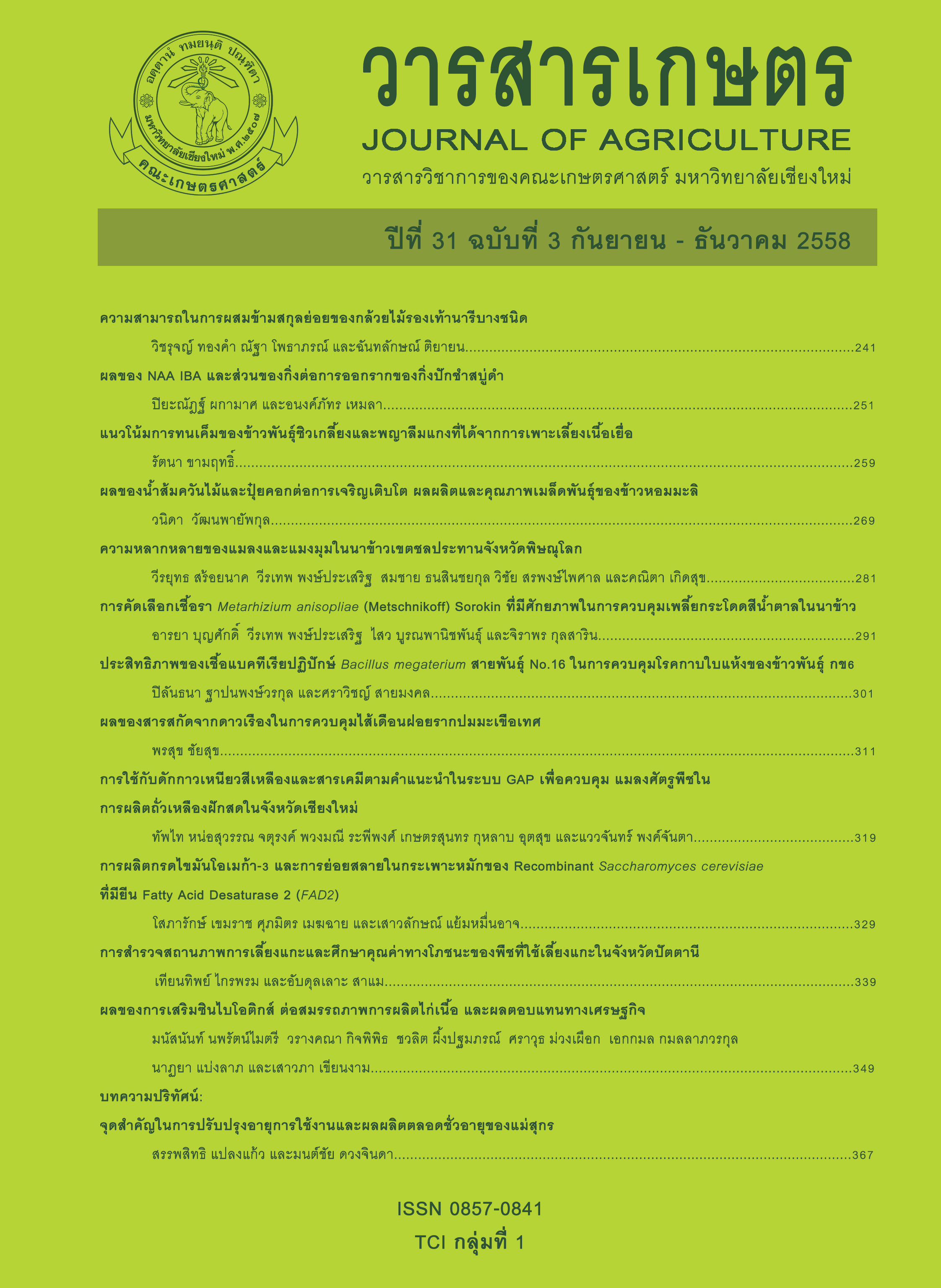การผลิตกรดไขมันโอเมก้า-3 และการย่อยสลายในกระเพาะหมักของ Recombinant <I>Saccharomyces cerevisiae </I> ที่มียีน Fatty Acid Desaturase 2 (<I>FAD2</I>)
Main Article Content
บทคัดย่อ
วัตถุประสงค์ในการศึกษาครั้งนี้ เพื่อผลิต recombinant Saccharomyce cerevisiae ที่มีชิ้นส่วนของยีนที่ถูกคัดแยกมาจาก Saccharomyce kluyveri และประเมินปริมาณกรดไขมันโอเมก้า-3 จาก recombinant S. cerevisiae รวมทั้งประเมินค่าการย่อยสลายในกระเพาะหมักของอาหารหยาบที่ได้รับการเสริม recombinant S. cerevisiae DNA ที่สกัด จาก S. kluyveri นำไปทำปฏิกิริยา PCR amplification โดยใช้ fatty acid desaturase 2 primer (FAD2) ผลผลิต PCR นำไปโคลนโดย pTA2 พลาสมิดเวกเตอร์ แล้วนำเข้าไปยัง S. cerevisiae หลังจากนั้นวิเคราะห์กรดไขมันโดยใช้ Gas chromatography และหาค่าการย่อยสลายในกระเพาะหมักโดยวิธี in vitro gas production technique มีการจัดกลุ่มทดลองด้วยวิธี 3x3 factorial ในแผนการทดลองแบบสุ่มโดยตลอด (CRD) ประกอบด้วย 2 ปัจจัย ปัจจัยที่ 1 คือ ชนิดของอาหารหยาบ ประกอบด้วย หญ้าเนเปียร์หมัก หญ้ากินนีหมัก และ ฟางข้าว ปัจจัยที่ 2 คือ การเสริมยีสต์ ประกอบด้วย กลุ่มควบคุม (C), กลุ่มที่เสริม S. cerevisiae (SC) และกลุ่มที่เสริม recombinant S. cerevisiae ที่มียีน FAD2 จาก S. kluyveri (SCSK) ประกอบด้วย 9 กลุ่มทดลอง ทำการเก็บน้ำจากกระเพาะรูเมนจากโคพื้นเมืองจำนวน 4 ตัว ทำการวัดปริมาณแก๊ซที่ 2, 4, 6, 8, 10, 12, 24, 48, 72 และ 96 ชั่วโมง และวัดปริมาณจุลินทรีย์ (microbial biomass yield, MBY) หลังจากการหมักย่อยที่ 24 ชั่วโมง จากการวิเคราะห์กรดไขมัน พบว่า กรดไขมัน Linoleic acid (C18:2, LA), Alpha-linolenic acid (C18:3, ALA) และ Eicosapentaenoic acid (C20:5, EPA) ของ recombinant S. cerevisiae มีปริมาณมากกว่า S. cerevisiae อย่างมีนัยสำคัญ สำหรับปริมาณแก๊สสุทธิที่เกิดขึ้นในชั่วโมงที่ 2-12 ของหญ้าเนเปียร์หมักมีค่าสูงที่สุด ปริมาณแก๊สสุทธิที่ 24 ของอาหารหยาบที่เสริมด้วย recombinant S. cerevisiae จะมีปริมาณแก๊สสุทธิสูงที่สุด สรุปได้ว่า recombinant S. cerevisiae สามารถผลิต LA, ALA และ EPA ได้มากกว่า S. cerevisiae อาหารหยาบที่เสริมด้วย recombinant S. cerevisiae จะมีปริมาณ OMD และ SCFA สูงที่สุด
Article Details
เอกสารอ้างอิง
ปิ่น จันจุฬา และ อัจฉรา เพ็งหนู. 2557. การทดแทนกากถั่วเหลืองด้วยกากเนื้อในปาล์มน้ำมันหมักยีสต์ในอาหาร ข้นต่อการย่อยได้ และความเข้มข้นของกรดไขมันระเหยได้ในกระเพาะของแพะ. วารสารเกษตร 30(2): 181-190.
เสาวลักษณ์ แย้มหมื่นอาจ. 2542. การประเมินค่าพลังงานสุทธิและการศึกษาการย่อยได้ของฟางข้าวในโคนมและแกะ. วิทยานิพนธ์วิทยาศาสตรมหาบัณฑิต สาขาวิชาสัตวศาสตร์ บัณฑิตวิทยาลัยมหาวิทยาลัยเชียงใหม่, เชียงใหม่ 113 หน้า
อัจฉราวรรณ ทองมี. 2530. การสกัดกรดไขมันจากยีสต์ Rhodotorula gracilis. วิทยานิพนธ์ปริญญาวิทยาศาสตร์มหาบัณฑิต สาขาเทคโนโลยีชีวภาพ คณะพลังงานและวัสดุ มหาวิทยาลัยเทคโนโลยีพระจอมเกล้าธนบุรี, กรุงเทพ. 100 หน้า
Bluemmel, M. and E. R. Orskov. 1993. Comparison of in vitro gas production and nylon bag degrability of roughage in predicting feed intake in cattle. Animal Feed Science and Technology 40: 109-119.
Blummel, M., H. P. S. Makkar and K. Becker.1997. In vitro gas production: a technique revisited. Journal of Animal Physiology and Animal Nutrition 77: 24-34.
Chemler, J. A., Y. Yan and M. A. Koffas. 2006. Biosynthesis of isoprenoids, polyunsaturated fatty acids and flavonoids in Saccharomyces cerevisiae. Microbial Cell Factories. 5:20.
Denev. S. A., Tz. Peeva, P. Radulova, N. Stancheva, G. Staykova, G. Beev, P. Todorova and S. Tchobanva. 2007. Yeast Cultures in Ruminant Nutrition. Bulgarinan Journal of Agricultural Science 13: 357-374.
Elisashvili V., N. Peninckx, E. Kachlishvili, T. N. Siklauri, E. Metreveli, T. Kharziani and G. Kvesitadze. 2007. Lentinus edodes and Pleurotus species lignocellulolytic enzymes activity in submerged and solid-state fermentation of lignocellulosic wastes of different composition. Biotec 99(3): 457-462.
Girard, I. D. and K. A. Dawson. 1995. Effect of a yeast culture on growth characteristics of representative ruminal bacteria. Journal of Animal Science 73:264.
Gregory, M. K., R. A. Gibson, R. J. Cook-Johnson, L. G. Cleland and M. J. James. 2011. Elongase Reactions as Control Points in Long-Chain Polyunsaturated Fatty Acid Synthesis. PLOSONE 6(12): 1-9.
Han., W. Y. 1975. Microbial fermentation of rice straw: nutritive composition and in vitro digestibility of the fermentation products. Applied Microbiology 29(4): 510-514.
Jean-Luc, S., 2012. Yeast Genomes Saccharomyces kluveri. (Online). Available: http://genolevures.org/sakl.html (December 5, 2014)
Kainou., K., Y. Kamisaka, K. Kimura and H. Uemura. 2006. Isolation of Δ12 and ω3-fatty acid desaturase genes from the yeast Kluyveromyces lactis and their heterologous expression to produce linoleic and α-linolenic acid in Saccharomyces cerevisiae. Wiley InterScience 23: 605-612
Kajiwara., S., T. Oura and K. Shishido. 2001. Cloning of fatty acid synthase component FAS1 gene from Saccharomyces kluyveri and its functional complementation of S. cerevisiae fas 1 mutant. Yeast 18: 1339-1345.
Morrison., R. W. and M. L. Smith. 1964. Preparation of fatty acid methyl esters and dimethylacetals from lipid with boron fluoride-methanol. Journal of Lipid Research 5: 600-608.
Simopoulos., P. A. 2012. The omega-6/omega-3 fatty acid ratio: health implications. Nutrition-Sante 17: 267-275.
Steel, R. G. D. and J. H. Torrie. 1984. Principles and Procedures of Statistics (2nd Ed.). MC Graw Hill Book Co; Singhapore. 672 p.
Van Soest, P. T. 1994. Nutritional Ecology of the ruminant. 2nd Ed. Cornell Univ. O&B Book, Inc. 476 p.
Watanabe., K., T. Oura., H. Sakai and S. Kajiwara. 2004. Yeast ∆12 fatty acid desaturase: gene cloning, expression, and function. Biosci. Biotechnol. Biochem 68(3): 721-727.


